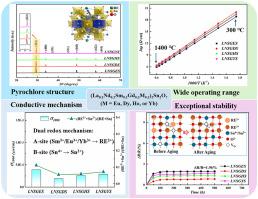用于负温度系数热敏电阻的高熵焦绿陶瓷(La0.2Nd0.2Sm0.2Gd0.2M0.2)2Sn2O7 (M = Eu, Dy, Ho或Yb)的电学性能和高温稳定性
IF 3.5
3区 化学
Q2 CHEMISTRY, INORGANIC & NUCLEAR
引用次数: 0
摘要
了解高温热敏陶瓷的电传输机制和关键热稳定性因素对于开发在极端热条件下高度稳定的温度传感器至关重要。本研究通过固态合成方法制备了高熵焦绿盐锡酸盐(La0.2Nd0.2Sm0.2Gd0.2M0.2)2Sn2O7 (M = Eu, Dy, Ho, Yb),在300-1400℃范围内表现出优异的负温度系数(NTC)行为。霍尔测量和x射线光电子能谱(XPS)分析揭示了这些陶瓷的双重氧化还原机制:在b位Sn4+部分还原为Sn2+,在a位稀土离子(Sm/Eu/Yb)部分还原为RE2+,产生空穴主导的p型电导率。该材料表现出优异的热稳定性,在1400℃下加热500 h后电阻漂移低于1.96%,这是由于其熵稳定的结构有效抑制了晶格无序转变。老化研究进一步表明,高氧空位浓度导致电阻漂移,因为在高温下充氧将RE2+氧化为RE3+,减少载流子,最终增加电阻率。本研究首次阐明了双位正离子价变化(Sn/RE)引起的空穴主导传导机制以及氧空位对高温稳定性的调控作用,为开发具有优异稳定性的下一代高温NTC传感器提供了重要的理论依据和材料设计策略。本文章由计算机程序翻译,如有差异,请以英文原文为准。

Electrical properties and high-temperature stability of high-entropy pyrochlore ceramics (La0.2Nd0.2Sm0.2Gd0.2M0.2)2Sn2O7 (M = Eu, Dy, Ho, or Yb) for negative temperature coefficient thermistor applications
Understanding electrical transport mechanisms and key thermal stability factors in high-temperature thermosensitive ceramics is essential for developing highly stable temperature sensors under extreme thermal conditions. This study develops the high-entropy pyrochlore stannates (La0.2Nd0.2Sm0.2Gd0.2M0.2)2Sn2O7 (M = Eu, Dy, Ho, or Yb) via solid-state synthesis, demonstrating exceptional negative temperature coefficient (NTC) behavior across 300–1400 °C. Hall measurements and X-ray photoelectron spectroscopy (XPS) analyses reveal a dual redox mechanism for these ceramics: partial reduction of Sn4+ to Sn2+ at B-sites and rare-earth ions (Sm/Eu/Yb) to RE2+ at A-sites, generating hole-dominated p-type conductivity. The materials exhibit outstanding thermal stability, with resistance drift below 1.96 % after 500 h at 1400 °C, attributed to the entropy-stabilized structure that effectively suppresses lattice disorder transformation. Aging studies further demonstrate that high oxygen vacancy concentrations lead to resistance drifts, as oxygen filling at elevated temperatures oxidizes RE2+ to RE3+, reducing charge carriers and ultimately increasing resistivity. This study elucidates for the first time the hole-dominated conduction mechanism arising from dual-site cation valence changes (Sn/RE) and the regulation effect of oxygen vacancies on high-temperature stability, which provides an important theoretical basis and material design strategy for the development of the next-generation high-temperature NTC sensors with excellent stability.
求助全文
通过发布文献求助,成功后即可免费获取论文全文。
去求助
来源期刊

Journal of Solid State Chemistry
化学-无机化学与核化学
CiteScore
6.00
自引率
9.10%
发文量
848
审稿时长
25 days
期刊介绍:
Covering major developments in the field of solid state chemistry and related areas such as ceramics and amorphous materials, the Journal of Solid State Chemistry features studies of chemical, structural, thermodynamic, electronic, magnetic, and optical properties and processes in solids.
 求助内容:
求助内容: 应助结果提醒方式:
应助结果提醒方式:


